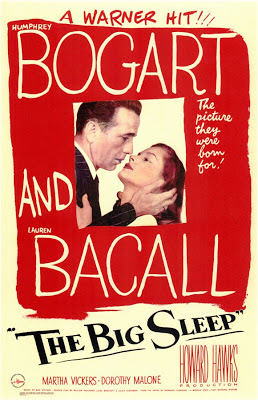The last thing I expected last evening was to see a piece of majolica in a Humphrey Bogart movie but there it was, in the opening scene of The Big Sleep, as big as life and twice as natural!
Filmed in 1944-45 and released in 1946, The Big Sleep is a classic Philip Marlow detective tale with Bogart as Marlow, Lauren Bacall and Martha Vickers as shady dames and a host of enough suspicious character actors for several movies. The movie is best known for the interplay between Bogart and Bacall and less known for a plot line that can, at best be described as confused.
The movie opens in the mansion of a wealthy man who has lots of strange goings on around him. He has called Marlow to his home to do some investigative work on his family. As Bogart awaits his meeting with the great man, bad girl Martha Vickers comes bouncing down the stairs all sex appeal and youthful exuberance. Before going into the parlor to speak to the detective, she pauses at the table in the entryway to pick up the mail. Right there in the center of the table is a large majolica vase filled with roses.
I can't say the exact design is familiar to me but the style is unmistakable. With a large central mask and acanthus leaves everywhere I would be greatly surprised if the manufacturer was anyone but Wilhelm Schiller & Son.
No one did masks and acanthus leaves as prolifically as WS&S. Combined with the restrained color palette common to the Bohemian potters the piece practically identifies itself as the Austrian majolica manufacturer or one of his followers.
majolica
Most likely it was acquired from Sherwood Hall. The contents of the Hopkins residence were purchased by Warner Brothers in the early 1940s. Other Victorian pieces from the sale would later appear in movies such as Annie, My Fair Lady and Rhapsody in Blue.
It was a totally unexpected surprise, but a very cool one. Now, I just need to keep an eye open at auction for the actual shape itself!
To view The Big Sleep trailer go here.








































)0EmGDBPFeDyWV9w~~60_3.JPG)













BPOwRk59(Q~~60_57.JPG)
